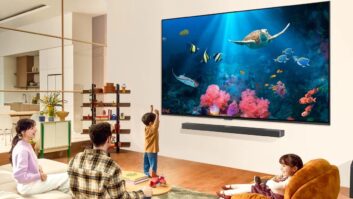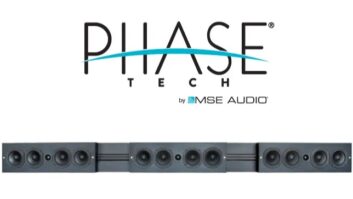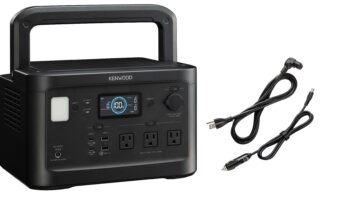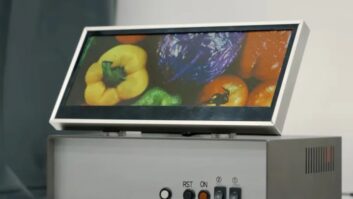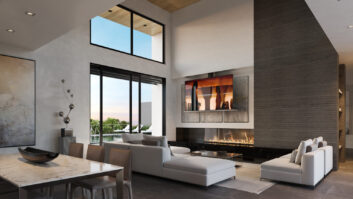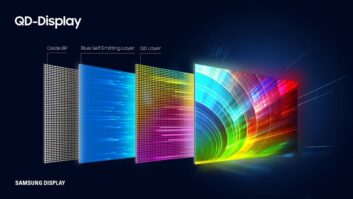RetailVision Spring 2004 attracted more than 206 vendors and 200 retailer representatives to the California desert, braving unseasonable 100-degree heat to view a slew of new products, which for the first time included several CE devices, such as flat-panel TVs and DVD players.
The new products included flat-panel televisions from KiSS Technology, Maxent and Syntax, while on the PC side of the show Ricavision showed off a new Media Center PC, Buffalo Technology USA had new wireless home-networking devices, and Antec unveiled a new do-it-yourself PC kit.
KiSS’ Coolview LCD line will include 17-inch, 22-inch and 30-inch models. All are HD-ready, have 400-to-1 contrast ratios, a TV-tuner, stereo speakers, picture-in-picture, Ethernet and wireless-networking ability and USB 2.0. The latter two models also include a built-in DVD player. The 17-inch will ship in June with an $899 suggested retail price. The 22-inch and 30-inch versions will follow in the third and fourth quarters, respectively. Pricing has not been set.
In September KiSS will ship a 42-inch plasma display with a $6,999 suggested retail. Like the other models it will have a built-in DVD player with DivX compatibility.
Regent USA showed its Maxent brand of flat-panel televisions, originally debuted in January at CES, along with the new MX-RS215 DVD+R/+RW recorder. The company currently sells LCD models with screen sizes ranging from 20 inches to 30 inches and plasma models of 42 inches and 50 inches. These are being sold through distribution and Costco at what the company described as very aggressive price points.
Advent reported at the show plans to enter the LCD-TV market in September. The initial product will be a high-end 27-inch model with a suggested retail price in the $1,499 to $1,799 range. Advent already sells CRT models.
Syntax USA said that it will broaden its Olevia LCD line to include a 20-inch model, priced at $699, by June or July and follow it in September with a 37-inch version. Pricing has not been set for this product. The company has no plan to roll out plasma models, said Dennis Karpeles, Syntax’s senior VP, sales and marketing.
Creating and maintaining a niche for itself in the increasingly crowded LCD market is not going to be an easy task, Karpeles said, but delivering high-end features, such as 750-to-1 contrast ratios, having six instead of just three backlights and offering free at-home customer service will attract the knowledgeable, price-conscious consumer.
Another differentiating factor is that Syntax is part owner of the Taiwan-based manufacturer making the products, and the factory also has a financial stake in Syntax, he said.
Syntax also will shake up its notebook computer line by culling its current 17 SKU lineup down to three or four models.
Despite the presence of so many CE firms, the bulk of the RetailVision exhibitor list was comprised of the shows traditional computer-centric firms.
Ricavision, a Netherlands-based firm, was at RetailVision for the first time to introduce the Plix Media Center. The Plix MCE 2800 and MCE 3200 will ship in July with suggested retails of $2,499 and $2,999. Company executives said Circuit City, Best Buy and Good Guys are expected to be the first retailers on board. The 2800 is powered by an Intel 2.8GHz Pentium 4 processor, with 512MB of DDR memory, 80GB hard drive, 40GB slim hard drive and a CD-RW/DVD-ROM drive. The 3200 differs by being bundled with 1GB of DDR memory, 120GB hard drive and 60GB slim hard drive.
The products are designed for living-room use and the company is downplaying its computing ability, instead hyping their multimedia capabilities.
“We do not want people to see the Plix as a PC,” said Jury Balta, Ricavision’s product manager.
Antec, a maker of computer kits and upgrade accessories, showed the Aria PC kit. The Aria, suggested retail price $129, has the appearance of an oversized toaster and comes with a 300-watt power supply, an 8-in-1 card reader and four PCI slots. It is shipping in mid-May.
Antec is also looking to expand its customer-base outside the tech-types that normally enjoy building and suping up their own computer, said Kareem Fahmi, Antec’s creative director. This effort will follow several tracks. The first is selling product through a new line of retailers like Staples. John Smith, Antec’s eastern regional sales manager, said the average Staple’s customer is computer-savvy enough to crack open a PC and install new hardware.
In an effort to attract more people into the build-your-own computer circle, Antec will expand its advertising to include high-tech books like Wired, instead of relying strictly on PC enthusiast publications.
The third leg of Antec’s strategy is the addition of tutorials to the company Web site that will instruct the novice computer builder in proper techniques, Fahmi said.
Buffalo Technology was on hand to discuss its newest home-networking technology, called AirStation OneTouch Secure System (AOSS). AOSS enables a consumer to quickly set up WEP-level security for a wireless network by pushing one button on the back of the router and clicking on another button on the onscreen user interface. The AOSS equipped router and notebook adapter will ship this month with respective suggested retail prices of $125 and $99.
Visioneer displayed its first Xerox-branded products, a duplex scanner that will ship in May with a $999 price tag. It is targeted at corporate sales departments that purchase equipment at retail or through the major chain’s corporate sales departments.
First Intelligent Array (FIA) has started shipping its On3 Digital Media Player line.
The company said the two-SKU line is now available online through retailers, including Tiger Direct and PC Connection and also direct from FIA, and it was showing the devices to retailers at RetailVision, hoping to have it sold through that channel. Audio, video and digital-imaging content is loaded onto the device’s hard drive by either an Ethernet home network or direct cable connection between the On3 and a PC. It then uses the same network to disperse the content to a home’s A/V components.
The 80GB-based On3 has a $449 suggested retail, and the 120GB version is $599.





